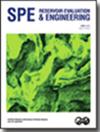阿萨巴斯卡从头到脚跟空气喷射飞行员:基于表观原子氢碳比变化的自燃评价
IF 1.5
4区 工程技术
Q3 ENERGY & FUELS
引用次数: 2
摘要
研究人员对Athabasca的三对井(每对井由一个垂直注入器和一个水平生产器组成)进行了深入分析,通过增强自燃(ESI)方法确定了点火延迟。ESI包括在开始注空气之前,通过注入蒸汽段塞对注水井周围环境进行3到4个月的预热。首先,根据产油量和观察井以及水平井趾部记录的井底温度(bht)来确定点火延迟时间。本文根据长时间详细气体分析计算的表观原子氢碳比(AAHCR)随时间的变化进行了更严格的评价。AAHCR是一个非常强大的合成参数,可以直接指示原位燃烧(ISC)锋面产生之前、期间和之后的峰值温度。因此,它提供了关于高温氧化和低温氧化(LTO)反应发生的完整信息。利用AAHCR的变化,发现点火时间比上述方法确定的时间短。在第一口井对的情况下,点火时间为3周,而之前的方法确定的点火时间为1个月。与之前计算的2个月相比,第二对井的点火时间为1个月,而第三对井的点火时间约为2个月。作为一种附加和补充的方法,点火时间的估计也是基于产生的气体的各个成分的变化。这使得一种测定点火时间的新方法得以发现。这在THAI过程中是可能的,不像传统的ISC过程,产生显著浓度的氢(H2),其变化的解释可以给出点火时间的指示。新方法使用起来非常简单,因为只有在ISC锋面完全建立之后,产氢气体中的氢气百分比才开始上升,因为氢气的产生与ISC锋面的高温键断裂反应有关。一般情况下,使用这种方法时,会在一定程度上高估点火延迟。本文章由计算机程序翻译,如有差异,请以英文原文为准。
Athabasca Toe-to-Heel Air Injection Pilot: Evaluation of the Spontaneous Ignition Based on Apparent Atomic Hydrogen-Carbon Ratio Variation
An in-depth analysis was performed to determine the ignition delay via the enhanced spontaneous ignition (ESI) method on three well pairs (each pair constituted by one vertical injector and one horizontal producer) belonging to the Toe-To-Heel Air Injection (THAI) pilot in Athabasca. ESI consisted of preheating of the surroundings of injection wells by injecting a steam slug for 3 to 4 months just before starting air injection. At first, the ignition delay had been determined based on both the oil production and on the bottomhole temperatures (BHTs) recorded in the observation wells as well as at the toe of the horizontal producer. For the purposes of this paper, a more rigorous evaluation was carried out based on the variation in time of the apparent atomic hydrogen-carbon ratio (AAHCR) calculated from detailed gas analyses for a long period of time. AAHCR is a very strong synthetic parameter giving a direct indication of the peak temperature value before, during, and after the in-situ combustion (ISC) front is generated. Therefore, it provides complete information on the occurrence of high-temperature oxidation and low-temperature oxidation (LTO) reactions. Using the variation of the AAHCR, it was found that the ignition time was shorter than those determined by the previously mentioned methods. In the case of first well pair, ignition took 3 weeks as compared to the 1 month determined by the previous methods. The second well pair ignited in 1 month as compared to the previously calculated 2 months, and for the third well pair, ignition time was approximately 2 months in both cases.
As an additional and complementary approach, estimation of the ignition time was also based on the variation of individual components of the produced gas. This allowed for the discovery of a new method for ignition time determination. This was possible in the THAI process, unlike conventional ISC processes, significant concentrations of hydrogen (H2) are produced, and the interpretation of its variation can give an indication of the ignition time. The new method is very simple to use, as the percentage of hydrogen in the produced gas starts to take off only after the full establishment of an ISC front, as hydrogen production is associated with high-temperature bond scission reactions in the ISC front. In general, the ignition delay is overestimated to some degree when using this method.
求助全文
通过发布文献求助,成功后即可免费获取论文全文。
去求助
来源期刊
CiteScore
5.30
自引率
0.00%
发文量
68
审稿时长
12 months
期刊介绍:
Covers the application of a wide range of topics, including reservoir characterization, geology and geophysics, core analysis, well logging, well testing, reservoir management, enhanced oil recovery, fluid mechanics, performance prediction, reservoir simulation, digital energy, uncertainty/risk assessment, information management, resource and reserve evaluation, portfolio/asset management, project valuation, and petroleum economics.

 求助内容:
求助内容: 应助结果提醒方式:
应助结果提醒方式:


